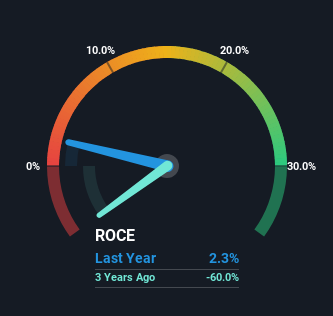- Australia
- /
- Oil and Gas
- /
- ASX:PEN
Investors Will Want Peninsula Energy's (ASX:PEN) Growth In ROCE To Persist

What are the early trends we should look for to identify a stock that could multiply in value over the long term? Amongst other things, we'll want to see two things; firstly, a growing return on capital employed (ROCE) and secondly, an expansion in the company's amount of capital employed. If you see this, it typically means it's a company with a great business model and plenty of profitable reinvestment opportunities. So when we looked at Peninsula Energy (ASX:PEN) and its trend of ROCE, we really liked what we saw.
Return On Capital Employed (ROCE): What Is It?
Just to clarify if you're unsure, ROCE is a metric for evaluating how much pre-tax income (in percentage terms) a company earns on the capital invested in its business. The formula for this calculation on Peninsula Energy is:
Return on Capital Employed = Earnings Before Interest and Tax (EBIT) ÷ (Total Assets - Current Liabilities)
0.023 = US$2.4m ÷ (US$119m - US$14m) (Based on the trailing twelve months to December 2022).
Therefore, Peninsula Energy has an ROCE of 2.3%. In absolute terms, that's a low return and it also under-performs the Oil and Gas industry average of 16%.
View our latest analysis for Peninsula Energy

Above you can see how the current ROCE for Peninsula Energy compares to its prior returns on capital, but there's only so much you can tell from the past. If you're interested, you can view the analysts predictions in our free report on analyst forecasts for the company.
SWOT Analysis for Peninsula Energy
- Currently debt free.
- Shareholders have been diluted in the past year.
- Forecast to reduce losses next year.
- Has sufficient cash runway for more than 3 years based on current free cash flows.
- Trading below our estimate of fair value by more than 20%.
- No apparent threats visible for PEN.
What Does the ROCE Trend For Peninsula Energy Tell Us?
We're delighted to see that Peninsula Energy is reaping rewards from its investments and has now broken into profitability. The company was generating losses five years ago, but has managed to turn it around and as we saw earlier is now earning 2.3%, which is always encouraging. While returns have increased, the amount of capital employed by Peninsula Energy has remained flat over the period. That being said, while an increase in efficiency is no doubt appealing, it'd be helpful to know if the company does have any investment plans going forward. Because in the end, a business can only get so efficient.
Our Take On Peninsula Energy's ROCE
As discussed above, Peninsula Energy appears to be getting more proficient at generating returns since capital employed has remained flat but earnings (before interest and tax) are up. Given the stock has declined 12% in the last five years, this could be a good investment if the valuation and other metrics are also appealing. So researching this company further and determining whether or not these trends will continue seems justified.
Peninsula Energy does come with some risks though, we found 2 warning signs in our investment analysis, and 1 of those is concerning...
While Peninsula Energy may not currently earn the highest returns, we've compiled a list of companies that currently earn more than 25% return on equity. Check out this free list here.
New: Manage All Your Stock Portfolios in One Place
We've created the ultimate portfolio companion for stock investors, and it's free.
• Connect an unlimited number of Portfolios and see your total in one currency
• Be alerted to new Warning Signs or Risks via email or mobile
• Track the Fair Value of your stocks
Have feedback on this article? Concerned about the content? Get in touch with us directly. Alternatively, email editorial-team (at) simplywallst.com.
This article by Simply Wall St is general in nature. We provide commentary based on historical data and analyst forecasts only using an unbiased methodology and our articles are not intended to be financial advice. It does not constitute a recommendation to buy or sell any stock, and does not take account of your objectives, or your financial situation. We aim to bring you long-term focused analysis driven by fundamental data. Note that our analysis may not factor in the latest price-sensitive company announcements or qualitative material. Simply Wall St has no position in any stocks mentioned.
About ASX:PEN
Peninsula Energy
Operates as a uranium exploration company in the United States.
Exceptional growth potential and good value.
Similar Companies
Market Insights
Community Narratives




